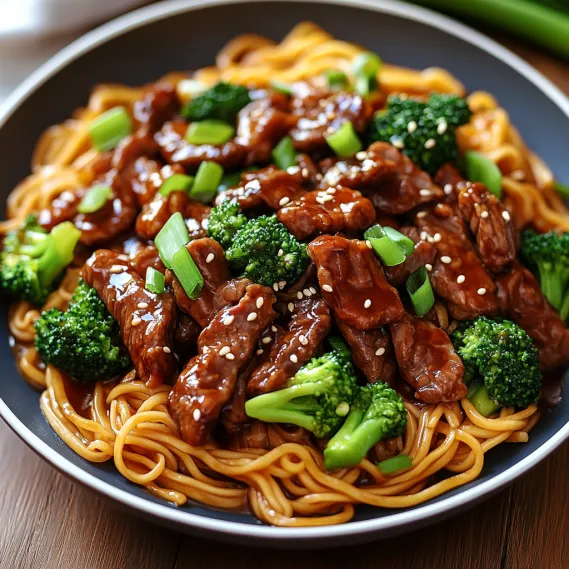 Pin it
Pin it
Sticky beef noodles are a deliciously satisfying dish that combines tender beef, chewy noodles, and a savory sauce that's sure to please any palate. This recipe is perfect for busy weeknights or a cozy weekend dinner, offering a burst of flavors and textures in every bite. Ready in just 25 minutes, it's an ideal solution when you need something delicious without spending hours in the kitchen.
Last night, I whipped this up after a particularly exhausting day at work, and even my teenage son, who typically turns his nose up at "homemade takeout," asked for seconds. That's when I knew this recipe was a true winner!
Essential Ingredients and Selection Tips
- Beef: Sirloin or flank steak sliced thinly against the grain ensures tenderness
- Rice Noodles: Soak up the sauce beautifully; substitute with lo mein or udon if preferred
- Cornstarch: Creates a velvety texture on the beef and thickens the sauce
- Hoisin Sauce: Delivers that signature sweet and umami flavor
- Fresh Ginger and Garlic: Provide aromatic depth; freshly minced makes a difference
- Vegetables: Red bell pepper and broccoli add color and nutrition
Detailed Cooking Instructions
- Prepare the Noodles: Cook rice noodles according to package instructions, usually soaking in hot water for 6-8 minutes until tender but still chewy. Drain and rinse with cold water to prevent sticking.
- Slice and Toss the Beef: Slice beef thinly against the grain for maximum tenderness. Toss with cornstarch to create a velvety texture and help the sauce adhere later.
- Create the Sticky Sauce: In a small bowl, whisk together hoisin sauce, honey or brown sugar, rice vinegar, sesame oil, and optional red pepper flakes. This balanced combination creates the perfect sticky-sweet flavor.
- Sear the Beef: Heat 2 tablespoons of oil in a large skillet or wok over high heat until shimmering. Add beef in a single layer and sear for 2-3 minutes until browned but still slightly pink inside. Remove from pan and set aside.
- Stir-Fry the Vegetables: In the same pan, add remaining oil and stir-fry bell peppers and broccoli for 4-5 minutes until crisp-tender. Add green onions, garlic, and ginger during the last minute to preserve their aromatic qualities.
- Combine Everything: Return the beef to the pan with the vegetables. Add the drained noodles and pour the prepared sauce over everything. Toss continuously for 2-3 minutes until the sauce thickens and coats everything with a glossy sheen.
- Adjust Seasonings: Taste and add more hoisin sauce for saltiness or honey for sweetness if needed. The sauce should be rich and balanced.
- Garnish and Serve: Divide among bowls and top with additional sliced green onions and sesame seeds. Serve immediately while hot and at peak stickiness.
- Optional Add-ins: For extra texture, sprinkle with chopped peanuts or cashews just before serving.
 Pin it
Pin it
I learned the importance of properly preparing the beef after my first attempt resulted in chewy, tough meat. Now I always slice thinly against the grain and use the cornstarch coating for that restaurant-quality tenderness.
Weeknight Time-Saving Strategies
This dish has become my secret weapon for hectic evenings when time is scarce but expectations remain high. I often slice the beef and chop vegetables during weekend meal prep, storing them separately in the refrigerator. The sauce components can be measured and combined up to three days ahead, requiring just a quick stir before using. With these advance preparations, dinner comes together in under 15 minutes on even the busiest nights.
 Pin it
Pin it
Versatility for Dietary Preferences
One reason this recipe appears frequently in our rotation is its adaptability for different dietary needs. For gluten-free guests, I simply swap in tamari for hoisin sauce and ensure my hoisin is gluten-free certified. Vegetarians enjoy this with firm tofu or tempeh, while plant-based diners appreciate it with mushrooms, which provide similar umami satisfaction. The sauce works beautifully with any protein, making it endlessly customizable.
Budget-Friendly Adaptations
When stretching our grocery budget, I've discovered several economical adjustments that maintain flavor while reducing cost. Using chuck steak or even ground beef works surprisingly well when properly seasoned. Increasing the vegetable-to-meat ratio stretches proteins further, and frozen mixed Asian vegetables can replace fresh ones during off-seasons. Rice noodles can be substituted with whatever pasta is on sale, though the texture differs slightly.
Perfect Pairing Suggestions
Complete your meal by serving these sticky beef noodles with complementary side dishes that enhance the experience. A tangy cucumber salad with rice vinegar dressing provides cooling contrast to the rich main dish. For appetizers, simple store-bought vegetable spring rolls or a clear broth soup work beautifully. Round out the meal with mango or lychee for dessert, offering a refreshing sweetness that cleanses the palate after the savory noodles.
 Pin it
Pin it
Final Thoughts
These sticky beef noodles have become one of my signature dishes, requested frequently by family and friends alike. The dish strikes that perfect balance between comforting and exciting, with the sticky sauce bringing everything together in delicious harmony. It's a wonderful example of how simple ingredients, properly prepared, can create something that rivals your favorite takeout.
Frequently Asked Questions
- → What type of noodles work best?
- Rice noodles are traditional, but lo mein, udon, or even ramen noodles work well.
- → How do I slice beef thinly?
- Freeze beef for 20 minutes before slicing against the grain with a sharp knife.
- → Can I make this with chicken?
- Yes, substitute thinly sliced chicken breast or thighs, adjusting cooking time accordingly.
- → How do I make this spicier?
- Add more red pepper flakes or include fresh sliced chili peppers.
- → What vegetables can I substitute?
- Try snap peas, carrots, mushrooms, or baby corn based on preference.
